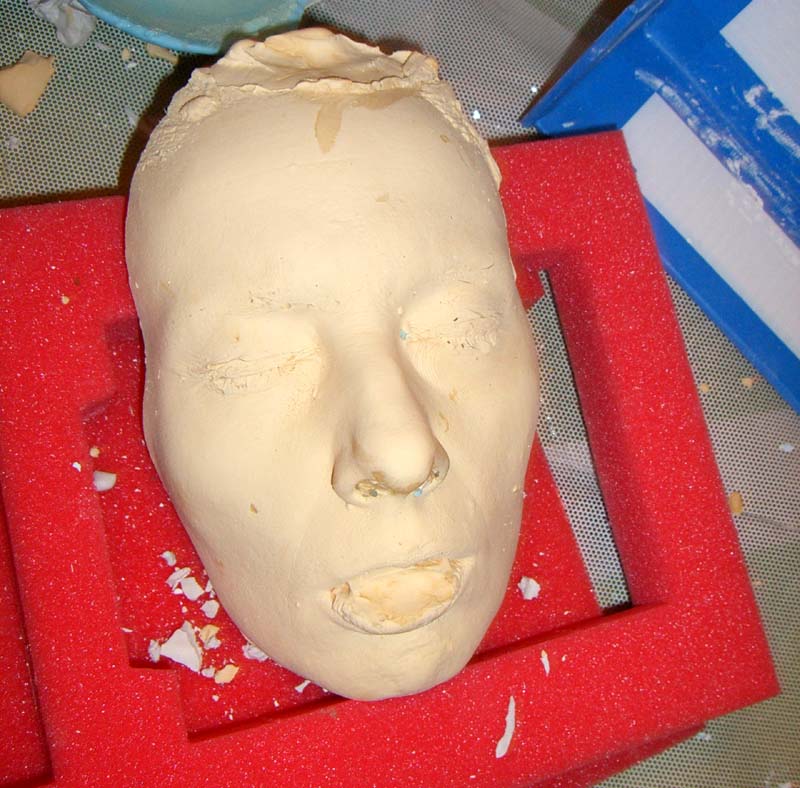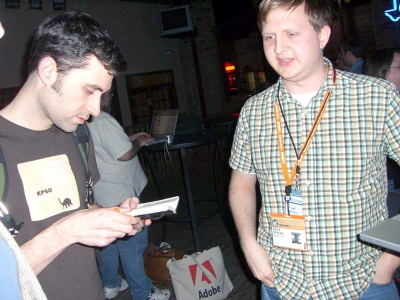Mykel and Paul (Steve's and my friends from the ACA) have this hobby, live-casting, where they make a cast of somebody's face or other body parts, fill it with water putty and turn it into a sculpture. Then they make masks based on that sculpture by way of vacuum forming. Mykel wanted to practice making face casts, and she asked if she could practice on me. I happily obliged -- it's not every day that you get to experience something like that. So, last weekend Mykel did a cast of my face.
The technique they use is to cover the "victim's" face with alginate -- gooey stuff that quickly sets and captures your facial features wery well. Too well, as we'll see later. Then when it sets, they put plaster on top of it. The purpose of plaster is to solidify the mold, because alginate alone, even when it's set, is too soft / wobbly.
The process made me feel a little more claustrophobic than I would like.
When I say they cover your face with goo, I mean they cover
everything, including your eyes (which are, of course, shut), and your mouth. The only hole left open in your face is your nostrils, and only because
you have put straws into them prior to casting, otherwise you wouldn't be able to breathe. As one can imagine, having your eyes and mouth
glued shut by a thick layer of goop feels a bit disconcerting. Claustrophobic, even. The catch is that anxious or not, you are supposed to maintain a relaxed, pleasant facial expression. Alginate is extremely sensitive to your facial features, it captures every tiniest detail of your skin, including fine lines, pores and zits. Soooo, if you frown or scrunch your eyes, your mask will feature ridges and valleys in the corresponding places. It was a tough order for me and I didn't do well at it, so the results of my cast were a bit disastrous, as we'll see later.
It doesn't help that I can't breathe through my nose
Fortunately or not, the first time Mykel applied alginate to my face, it set too quickly, before she could spread it completely. So she had to take it off and try again, using colder water to make alginate mixture. During the first try I realized I won't be able to breathe the whole time (close to an hour) through the straws in my nose. I have trouble breathing through the nose for long periods of time. Paul and Mykel addressed this problem by making a mouthpiece for me corrugated cardboard that
allowed me to breathe through my mouth. (The little tunnels in the corrugated cardboard serve that purpose very well.) However, in the end it turned out that it kind of ruined the cast: it was way to big to allow me maintain a natural shape of my lips. Paul and Mykel did not have experience with mouthpieces: all the people they've done casts off were able to breathe with only the straws in their noses.
After the alginate was set (which took about 5 minutes this time), Mykel
applied plaster to my face. The more plaster is applied, the heavier the mask feels (plaster is heavier than alginate); also, while a layer of alginate on your face still lets you see the light in the back of your eyelids, plaster shuts the light out completely, and you are left sitting in total darkness. It made the claustrophobic feeling a bit more intense. Fortunately, the darkness / heaviness increases gradually, so you have time to adjust to it.
The result was not flattering
Once plaster was set (or "cured" -- the word Mykel used) I finally got to peel the mold off my face. I could hardly wait for that moment. Not so much to see the
intermediate product, as to be free again! To see the light!
Then Mykel mixed some water putty and poured it into the mold. It quickly set. Then she took the cast -- the water putty product -- out of the mold, and I finally got to see the likeness of me!

As one can see, my eyes are scrunched and I look like I'm about to vomit. The vomiting effect is due to the mouthpiece I was holding in my mouth for breathing. We concluded it was way too big. To preserve a natural shape of a person's lips, a much, much smaller, discrete mouthpiece would be needed. The best thing, of course, would be to go without it and just breathe through the straws in the nose, which is what Paul and Mykel did when they made casts of each other's faces. Since I can't do that very well, I'm probably not a good candidate for a face-casting model. The scrunching of the eyes is, of course, due to the difficulty maintaining a relaxed facial expression in these circumstances, as I said above. The instinct that screams "I'm being burried alive!" in your head is pretty hard to shut up.
More pictures of face casting can be found
in my blog post documenting the facecasting process.








